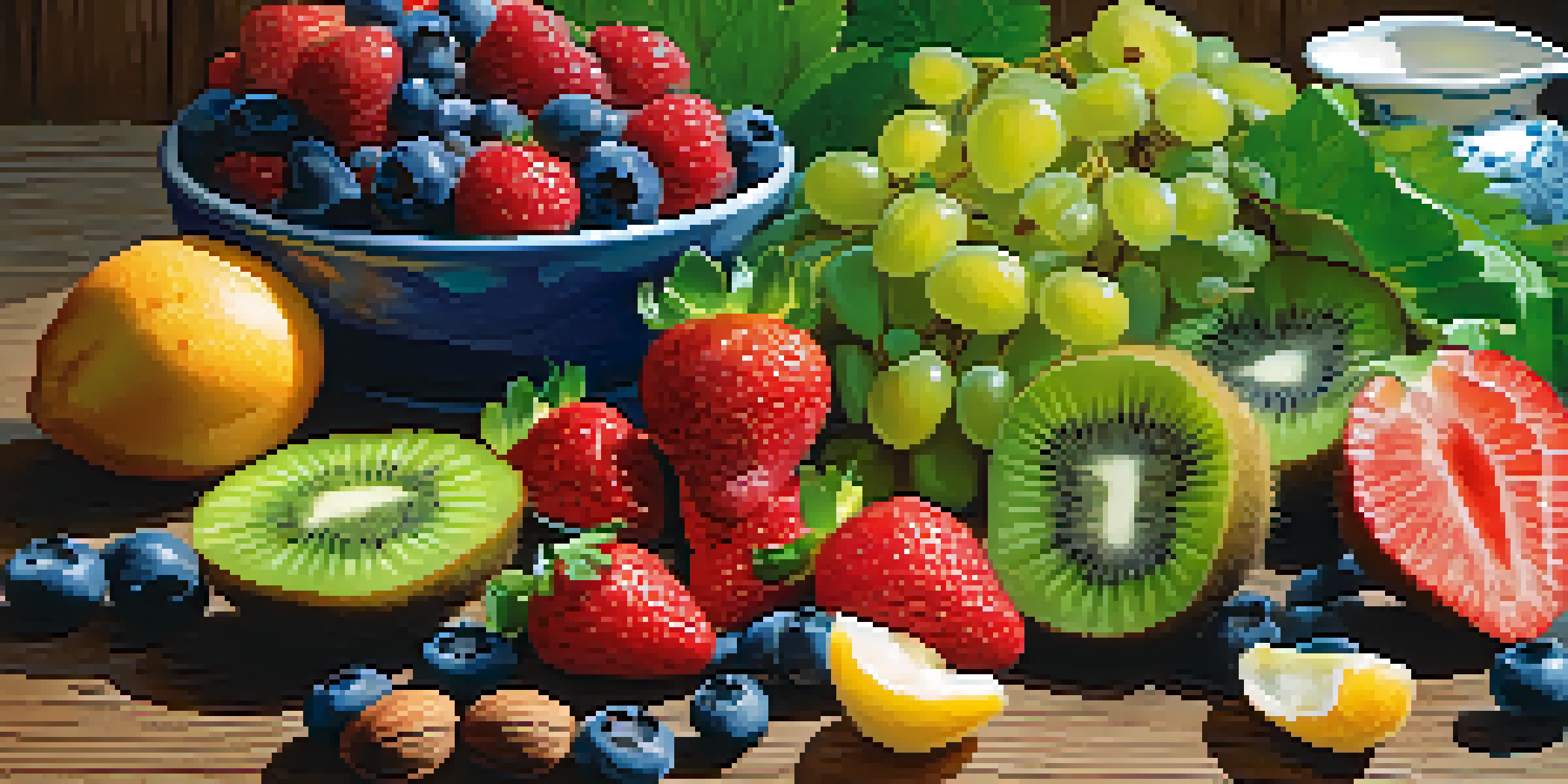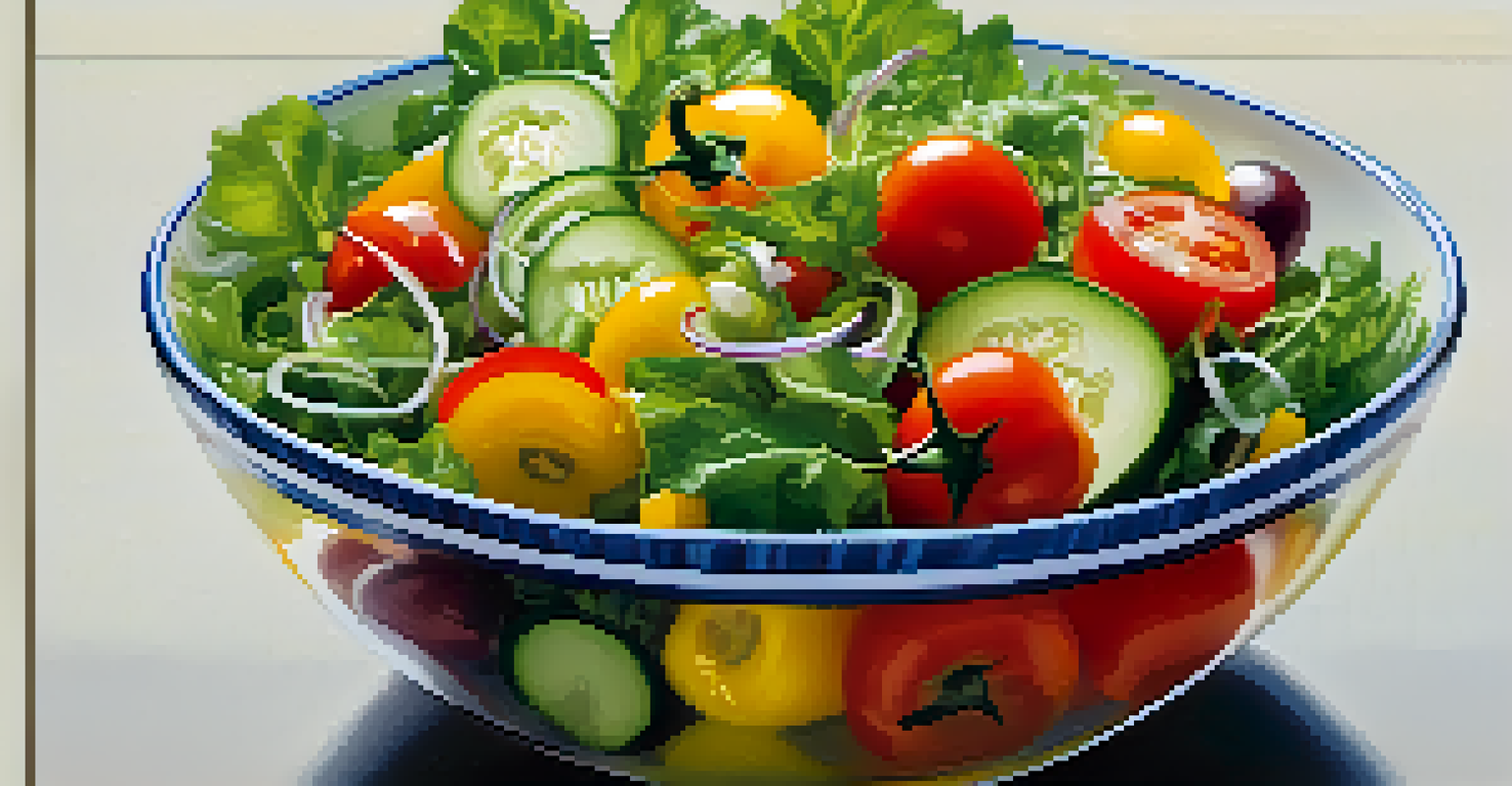Exploring Raw Foods: A Pathway to Cancer Prevention

Understanding Raw Foods and Their Benefits
Raw foods refer to unprocessed and uncooked ingredients, often plant-based, that retain their natural enzymes and nutrients. This approach emphasizes consuming fruits, vegetables, nuts, and seeds in their most natural form. By choosing raw foods, individuals may experience better digestion and increased energy levels, as the body can more easily absorb the nutrients.
Let food be thy medicine and medicine be thy food.
One of the primary benefits of raw foods is their high antioxidant content, which helps combat oxidative stress in the body. Oxidative stress is linked to various chronic diseases, including cancer. Foods like berries, leafy greens, and nuts are rich in antioxidants and can play a significant role in enhancing overall health.
Moreover, raw foods are typically lower in calories and higher in fiber, making them an excellent choice for maintaining a healthy weight. Since obesity is a known risk factor for several types of cancer, integrating more raw foods into your diet could serve as a preventive measure.
The Role of Antioxidants in Cancer Prevention
Antioxidants are compounds found in various foods that help neutralize harmful free radicals in the body. Free radicals can cause cellular damage and contribute to the development of cancer over time. By incorporating antioxidant-rich raw foods into your diet, you may help reduce this damage and lower your risk.

Foods like kale, spinach, and sweet potatoes are packed with vitamins A, C, and E, all of which have antioxidant properties. These nutrients not only support immune function but also protect against DNA damage, which is crucial in cancer prevention. Consuming a variety of colorful fruits and vegetables ensures a broad range of antioxidants.
Benefits of Raw Foods for Health
Raw foods are nutrient-dense and can enhance digestion, energy levels, and overall health.
By focusing on raw foods, you can enjoy these powerful antioxidants in their most potent form. Cooking can sometimes diminish the nutritional value of certain foods, so embracing raw options can be a smart strategy for maximizing health benefits.
How Phytonutrients Support Health and Well-being
Phytonutrients are natural compounds found in plants that contribute to their vibrant colors and flavors. These compounds have been shown to offer various health benefits, including anti-inflammatory and anti-cancer properties. Raw foods are an excellent source of phytonutrients, making them a valuable addition to a cancer-preventive diet.
You are what you eat, so don't be fast, cheap, easy, or fake.
For example, the compound lycopene, found in tomatoes, has been associated with a lower risk of prostate cancer. Similarly, cruciferous vegetables like broccoli contain sulforaphane, which may help detoxify carcinogens. By consuming a wide variety of raw fruits and vegetables, you can harness the power of these phytonutrients.
Incorporating raw foods into your meals allows you to enjoy the full spectrum of these beneficial compounds. Smoothies, salads, and raw snacks can be delicious ways to boost your intake of phytonutrients while exploring new flavors and textures.
The Impact of Fiber on Digestive Health
Fiber is an essential component of a healthy diet, yet many people do not consume enough. Raw foods, particularly fruits, vegetables, and whole grains, are naturally high in fiber, which promotes healthy digestion. A diet rich in fiber can help regulate bowel movements and prevent constipation, reducing the risk of colorectal cancer.
Additionally, fiber supports a healthy gut microbiome, which plays a crucial role in overall health. A balanced gut microbiome can enhance immune function and reduce inflammation, both of which are vital in cancer prevention. By choosing raw foods, you can significantly increase your fiber intake.
Antioxidants Reduce Cancer Risks
Incorporating antioxidant-rich raw foods helps neutralize free radicals, potentially lowering cancer risk.
To reap the benefits of fiber, consider incorporating raw snacks like carrot sticks, apple slices, or a hearty salad into your day. These tasty options not only contribute to a healthier digestive system but also promote a sense of fullness, which can aid in weight management.
Exploring Raw Food Preparation Techniques
Transitioning to a raw food diet may seem daunting, but there are numerous preparation techniques that can make it enjoyable. Simple methods like soaking, sprouting, and blending can enhance the texture and flavor of raw ingredients. For instance, soaking nuts and seeds can make them more digestible and easier to incorporate into recipes.
Blending fruits and vegetables into smoothies or soups can create delicious meals that are packed with nutrients. This approach allows for creative combinations, making it easier to include various raw foods in your diet. You can even experiment with raw desserts using dates, nuts, and cacao for a healthy treat.
With a little creativity, raw food preparation can be both simple and satisfying. Embracing these techniques can help you discover new flavors and textures while enjoying the health benefits of raw foods.
Potential Challenges of a Raw Food Diet
While a raw food diet offers numerous benefits, it can also present challenges. One common issue is ensuring that you receive adequate nutrition, particularly concerning protein and certain vitamins. It's important to plan meals carefully to include a variety of food sources to meet your nutritional needs.
Another challenge is the social aspect of dining, as raw food options may not always be available at restaurants or gatherings. This can lead to feelings of isolation or frustration when trying to stick to a raw diet. However, being prepared with your own snacks or dishes can help navigate these situations.
Fiber Supports Digestive Health
High fiber content in raw foods promotes healthy digestion and may reduce the risk of colorectal cancer.
Lastly, some individuals may find it difficult to adjust to a raw food diet due to cravings for cooked foods. Gradually incorporating raw meals and experimenting with different recipes can help ease the transition while still enjoying the benefits of raw foods.
Consulting Professionals for Guidance
Before making significant changes to your diet, it's wise to consult with a healthcare professional or a registered dietitian. They can provide personalized advice and help you create a balanced raw food plan that aligns with your health goals. This guidance can be particularly valuable if you have specific health concerns or dietary restrictions.
Professionals can also assist in monitoring your nutrient intake to ensure you're not missing out on essential vitamins and minerals. They may suggest supplements or fortified foods if needed, allowing you to maintain optimal health while exploring raw foods.

Ultimately, seeking professional guidance can empower you to embrace a raw food lifestyle safely and effectively. With the right support, you can enjoy the benefits of raw foods while minimizing potential risks.